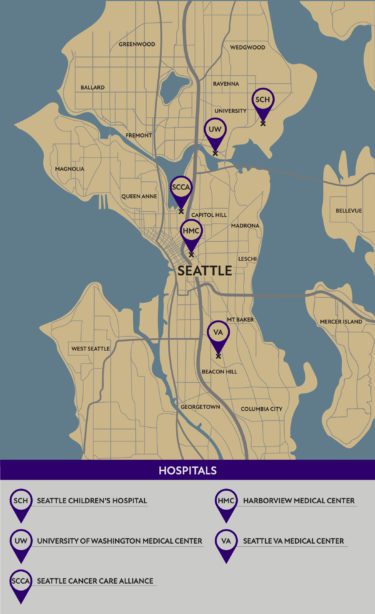Residency Programs

The University of Washington has a rich history in training IR physicians.
The entire IR section is an active clinical service, with several outpatient clinics, and an inpatient service with active participation by residents, medical students, physician assistants, and nurse coordinators. The overall goal of the Interventional Radiology Residency program is to merge imaging expertise with not only technical skills but also clinical skills. Trainees will be involved in all aspects of patient care including image interpretation, evaluation of new patients, procedures, inpatient and outpatient care, patient follow-up, and multidisciplinary boards (e.g., tumor boards.)
We currently have approval for up to three integrated residents per PGY and two independent residents. Typically, the DR program at UW can accommodate two ESIR resident per PGY.
More detailed information about Interventional Radiology Residency Programs can be found on the SIR website.
Clinical Work
Arterial Disease – thrombolysis, AVM interventions, PAD/CLI, aneurysm and pseudoaneurysm treatment (EVAR)
Oncology – chemo and radioembolization, irreversible electroporation (IRE)/nanoknife, percutaneous ablation (radiofrequency, microwave, cryo, ethanol)
Trauma – hemorrhage, solid organ injury management
GI Tract – TIPS, BATO/BRTO, endoscopic assisted biliary stone management, cholecystectomy tube, biliary dilation and stenting, portal vein recanalization, GI hemorrhage
GU Tract – nephrostomy, ureteral stents
Transplant interventions – UWMC transplant programs include liver, kidney, pancreas, heart and lung
Hemodialysis access – fistula and graft interventions and slavage
Lymphatic – lymphangiography, thoracic duct embolization
Venous – venous reconstruction, reconstruction, and stenting; IVC filter placement and retrieval, including advanced retrieval
Women’s Health – uterine artery embolization, fibroid treatment, pelvic congestion syndrome
Men’s Health – varicocele treatment, prostate artery embolization
Neurologic – acute stroke interventions, diagnostic cerebral angiography
Pain management – kyphoplasty and vertebroplasty, sacroplasty, bone ablation, and percutaneous sympathectomy
Clinical/Multidisciplinary – inpatient and outpatient consults, continuity of care, tumor boards, ICU, Vascular Ultrasound, GI/Hepatology
Hospitals

The IR service at the University of Washington and associated hospitals perform a full spectrum of vascular and nonvascular procedures in both adult and pediatric populations. IR rotation sites include University of Washington Medical Center, Harborview Medical Center, Seattle Children’s Hospital, Seattle Veteran’s Administration Medical Center, and Seattle Cancer Care Alliance.
Integrated Interventional Radiology Residency

The University of Washington is an ACGME accredited program for the Integrated IR Residency. Graduates of this program will complete overall two full years of training in IR and will be eligible for dual board certification in IR and DR. We currently have approval for three positions per year.
Application Process
Minimum eligibility criteria
1. A medical degree from one of the following:
-
- Accredited medical school in the United States or Canada
- Accredited college of osteopathic medicine in the United States
- Medical school outside of the United States or Canada, along with ECFMG certification
2. Passing scores on USMLE Step 1 (and Step 2 CK & CS if taken in time for ERAS submission)
ERAS Application
Complete ERAS application online.
Interviews
We typically offer about 30 interviews each year for 3 positions in the integrated program.
Specifics the selection committee takes into greatest consideration:
- Core clerkship grades, especially in surgical/procedural specialties
- Letters of recommendation, particularly from IR, DR, surgery, and/or medicine faculty
- Dean’s letter (MSPE); class standing
- USMLE scores
- Leadership and volunteer activities
- Research activity, particularly presentations and publications
Historically, most of our successful applicants have received honors in the majority of their core clinical clerkships (most notably in medicine and surgery) and were members of AOA. However, those applicants from schools that do not offer “honors” or AOA are not adversely affected.
We do not have a threshold for the USMLE Step 1 score, although applicants with lower scores generally have other considerable strengths in their application to be considered for an interview. Such other strengths include exceptional performance at a highly regarded medical school, high-caliber research, important leadership positions, or noteworthy volunteer activities.
Upcoming Interview Dates
Thursday, November 14, 2024
Thursday, November 21, 2024
Thursday, December 19, 2024
Thursday, January 2, 2025
Thursday, January 9, 2025
Thursday, January 16, 2025
We understand that with the COVID-19 pandemic, medical school rotations and opportunities may have been atypical. We commit to being receptive and adaptive in the new climate of remote interviews and understanding of diverse medical school experiences. All our interviews will take place via Zoom, and more details will be shared about that process if selected for an interview.
Independent Interventional Radiology Residency


The University of Washington is an ACGME approved program for the Independent IR Residency. Graduates from the program will be eligible to apply for certification in IR. We currently have approval for two positions per PGY. Candidates for the Independent Residency program include ESIR and non-ESIR DR residents.
Application Process
Both ESIR (approved or planning approval) and non-ESIR DR residents will apply during their PGY-4 year and would start as PGY-6.
For the most comprehensive information, please visit the SIR Independent IR Residency website.
Minimum eligibility criteria
1. A medical degree from one of the following:
-
- Accredited medical school in the United States or Canada
- Accredited college of osteopathic medicine in the United States
- Medical school outside of the United States or Canada, along with ECFMG certification
2. Passing scores on USMLE Step 1, 2 (CK & CS) and 3
3. Completion/Passing score on ABR Core Exam prior to starting Independent IR residency
4. Good standing in DR program on track to complete program
Additional ESIR applicants criteria:
5. Diagnostic Radiology Program Director Standardized Letter of Recommendation for ESIR Applicants (Independent IR Residency Match)
ERAS Application
Complete ERAS Application for NRMP Residency and Fellowship Match (ERAS website for Independent IR Residency)
Letters of Recommendation
We recommend 3-4 letters of recommendation in your application with at least two letters coming from IR faculty.
Interviews
Typically, we interview 20 applicants for 2 Independent IR position per application cycle.
Specifics the selection committee takes into greatest consideration:
- Quality and quantity of IR rotations
- Letters of recommendation, particularly from IR, DR, surgery, and/or medicine faculty
- Medical school performance: Clerkship grades; Dean’s letter (MSPE); class standing
- USMLE scores
- Leadership and volunteer activities
- Research activity, particularly presentations and publications
The UW will review applications from both ESIR and non-ESIR applicants. We will interview/rank candidates based on application quality and not whether candidates will train as an Independent IR resident for 1 or 2 years.
Upcoming Interview Dates Will Be Updated Soon
We understand that with the COVID-19 pandemic, clinical opportunities may have been atypical. We commit to being receptive and adaptive in the new climate of remote interviews and understanding of diverse experiences. All our interviews will take place via Zoom, and more details will be shared about that process if selected for an interview.
Early Specialization in IR - ESIR

The purpose of the ESIR program is to provide an alternative path for DR residents who identify an early desire to enter into IR. ESIR is a modification of the curriculum of the DR residency and is another option for IR training for some residents.
ESIR training requires a total of 11 interventional radiology or interventional radiology-related rotations (minimum of 44 weeks), and an intensive care unit (ICU) rotation of at least four continuous weeks within the four-year diagnostic radiology residency, with documentation of 500 IR or IR-related procedures. This will allow DR resident to enter the second year of an IR Independent Residency as a PGY-6 and complete the final year of training.
The University of Washington Diagnostic Radiology Residency Program offers Early Specialization in Interventional Radiology (ESIR) in conjunction with the Interventional Radiology Residency Program. One position is available for the PGY-4 class each year. The PGY-5 ESIR resident will join the group of seven senior IR residents in their PGY-5 and higher years (Integrated and Independent). The selection committee includes the Diagnostic Radiology Residency and Interventional Radiology Residency Program Directors and Associate Program Directors. Interested residents will submit an updated CV and a letter of interest by December 31 of their PGY-4 year. The committee will make its decision by February 1.
ESIR residents will apply for Independent IR Residency programs through the ERAS/NRMP match, and can apply to their home institution as well as other programs.